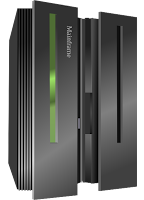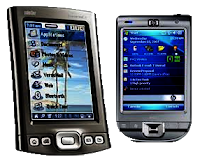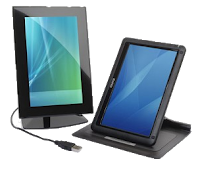Basic Computer Operations
The term Computer is derived from the Latin Computera, which means counting (to compute). At first the computer is only used as a calculating tool, but there is a difference between the computer and calculator.
Computers are used to assist and alleviate human tasks in the process of solving a variety of problems in their work, because computers have operating speeds, the ability to store in memory, and save costs.
 1. Elements of Computer System
1. Elements of Computer System · Hardware; equipment in the physical form of a
computer system running software that is a set of
instructions - the instructions given and the outcomes
in the form of human information used for the report.
Computer equipment consists of an input, processing
and output devices.
· - Software; series of procedures and documentation program that works to solve problems. The software running on the processing of the input data if it gets a response from the input device, and a processing results issued via the output device.
 will only work if the instructions given by brainware.
will only work if the instructions given by brainware.Brainware classified into four levels:
- System Analyst; Responsibility and planning
system of a development project and in particular the
development of an information system which utilizes
computer.
- Programmer; makers and officials are preparing for a required course
in the computerized system created and developed.
- Administrator; officers who manage the operating system and programs
running on a computer system or network.
- Operators; users who use a computer system that is ready to operate.
 2. Classification of Computers
2. Classification of Computersa. Based on the type of data processed
1) Analog Computers: to process the continuous
nature of the data, not the data rate, but in a
physical form such as an electric current,
temperature, velocity, pressure and others.
Output analog computer is usually a setting or
control of a machine being operated.
The advantage is the speed of analog computers
in the computer receives data in physical scale
and a direct process, without having to go
through the conversion process and the output
in graphical form. Shortage of analog computers, is located on the resulting
accuracy is still lower than the digital computer.
2) Computer Digital: to process the data in the
form of numbers and or letters. This kind of computer used for business and engineering
computer used for business and engineering
applications, such as PC and Laptop. Excess
speed digital computer is a level higher than
the analog computer, can store data, can
perform logic operations, the stored data
can be corrected. The resulting output can be
numbers, letters, charts, and pictures.

form of numbers and or letters. This kind of
 computer used for business and engineering
computer used for business and engineeringapplications, such as PC and Laptop. Excess
speed digital computer is a level higher than
the analog computer, can store data, can
perform logic operations, the stored data
can be corrected. The resulting output can be
numbers, letters, charts, and pictures.

3) Computer Hybrid; a combination of analog
computers and digital computers. Therefore,
it is used for specific applications, so that the
necessary computer faster than digital
computers and more precise than the analog
computer.
computers and digital computers. Therefore,
it is used for specific applications, so that the
necessary computer faster than digital
computers and more precise than the analog
computer.
b. Computer Based on Ability
1) Small Computer (small mainframe
computers), this kind of computer has
a memory capacity between 64 KB to 8
MB, can deal with dozens of computer
terminals that are separate fromthe
computer center.
computers), this kind of computer has a memory
between 512 KB to 8 MB, can handle hundreds of
computer terminals that are separate from
the computer center.
to 8 MB, and have a high speed. Can use the time sharing or computer users can simultaneously use the computer at the same time.

c. Computer Based Capacity and Dimensions
1) Super Computers; kind of computer with the fastest
speed. Used to handle applications involving complex
calculations, such as predicting the weather and spacecraft
design. Super computers using 9152 processors, Pentium
P6 at speeds of more than 1.3 trillion instructions per
second.
2) Mainframe Computers; very large computer
with speeds of 50 to 20,000 MFLOPS. Used to
handle the data processing very large volumes.
with speeds of 50 to 20,000 MFLOPS. Used to
handle the data processing very large volumes.
Used to serve a network with a simple terminal,
as a server at a medium scale company,
has a speed of 3 to 1,000 MLOPS.

4) Workstation; having the ability to solve complex
as a server at a medium scale company,
has a speed of 3 to 1,000 MLOPS.

4) Workstation; having the ability to solve complex
computing applications and has a speed of 50 to
500 MLOPS. This computer uses UNIX or NT
operating system and is equipped with a
powerful RISC processors such as Digital Alpha
or MIPS.
500 MLOPS. This computer uses UNIX or NT
operating system and is equipped with a
powerful RISC processors such as Digital Alpha
or MIPS.

5) Micro Computer; known as Personal computer or
desktop computer, has a speed of between 1 to 50
MLOPS. Using the DOS operating system, Windows,
Mac or other similar, is used for the application -
standard applications.
Micro computers are distinguished among others,
Desktop PC, Tower PC, Laptop, Notebook, Palmtop
(Handled PC), PDA (Personal Digital Assistant).
d. Computer Based Sector Issues
1) Special Purpose Computers; computers can only
solve one problem only, so that only certain
programs are put into the computer, such as a
computer that is used in oil refineries.
2) General Purpose Computers; computers can
solve various problems, namely digital and analog
computers. However the general digital computer,
such as computers for government offices, schools,
and small-scale enterprises.






